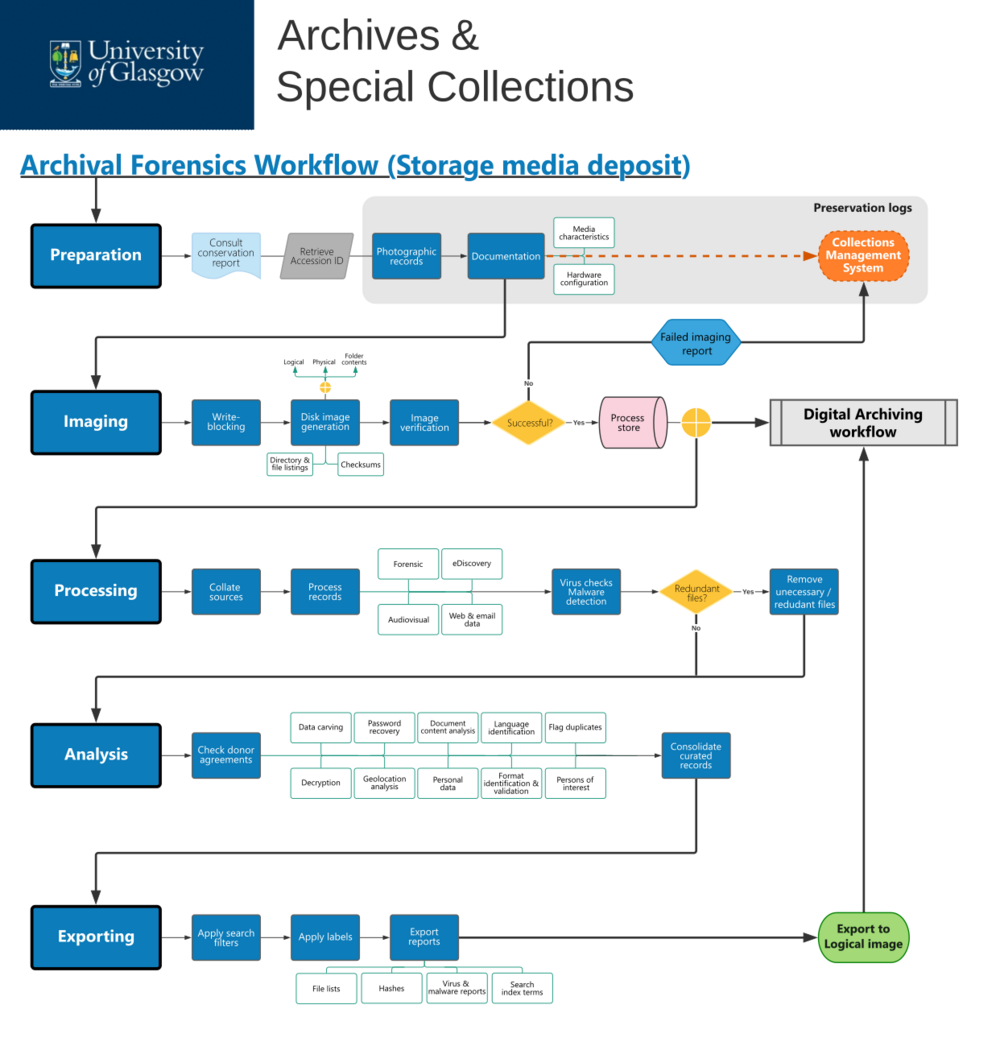Workflow:Archival Forensics workflow (storage media deposit)
Jump to navigation
Jump to search
Workflow Description
- START
- A request to forensically process a digital deposit (storage media) to the University of Glasgow Archives & Special Collections, as part of of the Digital Archiving workflow.
- PREPARATION
- Obtain supporting resources and materials to forensically process digital storage media.
- Consult the physical conservation and preservation report, documenting all actions on the acquired media and produced during Acquisition in the Digital Archiving workflow.
- Retrieve the unique accession number generated for the media to be processed from the Collections Management System. Use the accession number as reference in all forensic processing actions.
- Update the conservation and preservation logs on the Collections Management System relating to the storage media, including:
- photographic records of the storage media before processing, clearly showing state, serial number(s) and any other relevant information recorded on the media (e.g. labels).
- Documentation of media characteristics, such as technology, type, brand, model, serial number.
- Documentation of any hardware setup or configuration necessary to process the storage medium.
- Proceed to Imaging.
- IMAGING
- Create an exact copy of storage media, encapsulating contents and structures in a single file (a disk image).
- Use write-blocking tools (software or hardware) to only permit read-only access to storage media, so as to avoid compromising the integrity of the data; and protect the data chain of custody.
- Use disk imaging software to generate a forensic image file, which can either be:
- a physical image, which is a bit-by-bit (exact) copy of the storage medium and includes active (used) and free space. Any deleted data or file fragments will be copied into the image file.
- A logical image, which captures active data on the device but not any deleted space, deleted files or fragments.
- A selection of specific files and directories, also known as a targeted collection.
- Instruct the disk imaging software to create a complete file and directory listing; and verify the integrity of the generated image file by comparing hashes:
- If verification fails and attempts at re-imaging are unsuccessful, create a "failed imaging" report in the Collections Management System logs.
- If verification is successful, store the image in process store.
- Is further forensic processing and analysis required?
- If no, submit the verified disk image to the Digital Archiving workflow. OR
- If yes, proceed to Processing.
- PROCESSING
- Extract and manage information from the data in storage media, and make it available for analysis.
- Collate sources for processing, by selecting specific folders/files to review and - where appropriate - aggregating data from multiple storage media.
- Perform virus and malware detection checks on the collated sources.
- Use forensic software to identify and, if possible, remove irrelevant or redundant files from processing. Examples may include operating systems, system files, or user-defined files that have been deemed as irrelevant.
- Use forensic software to process the data, including hash generation for files; expanding compound files (e.g. zip archives); format identification and validation; creating search text indices; and preparing audiovisual, web and email data for analysis.
- Proceed to Analysis.
- ANALYSIS
- Use digital forensics methods to search, categorise, review, interpret and curate data in storage media, so as to aid selection and appraisal processes.
- Review the agreement(s) under which the records were donated, in order to identify permissible actions (e.g. whether restoring deleted files is allowed).
- Depending on the nature of the data and on archival needs, use forensic software to identify records of interest, and make them available for appraisal. Analysis methods may include:
- Data carving, for restoring data that was deleted or lost from the file system.
- Decrypting encrypted files and recovering passwords for password-protected files.
- Viewing and exporting geolocation data from files that have geolocation information associated with them.
- Analysing document content to explore terms/words of interest; and automate the identification of personal information, such as names, phone numbers, credit card and social security numbers.
- Identifying the language in which documents are written.
- Generating thumbnails from images and videos; and extracting metadata from multimedia files.
- Flagging duplicate files.
- Discovering information (including documents and email communications) relating to pre-defined lists of persons of interest.
- Once all analyses have been completed, consolidate the resulting data into an appropriate file/folder structure.
- Proceed to Exporting.
- EXPORTING
- Export the forensically analysed contents of storage media as logical disk images, alongside relevant processing reports, filters and labels.
- Export any custom filters and labels created to manage the data, which can be useful for other digital archiving processes. Filters help locate items of interest quickly; and labels allow for grouping files in customised ways (e.g. flagging content that requires archivist attention; or records associated with a specific individual).
- Export any reports generated during processing and analysis, such as file hashes, virus and malware detection reports, search index terms and geolocation data.
- Export the forensically curated contents of processed storage media into a logical disk image.
- Submit the logical disk image to the Digital Archiving workflow.
Purpose, Context and Content
Evaluation/Review
Further Information
Lkon115 (talk) 16:36, 7 November 2022 (UTC)
